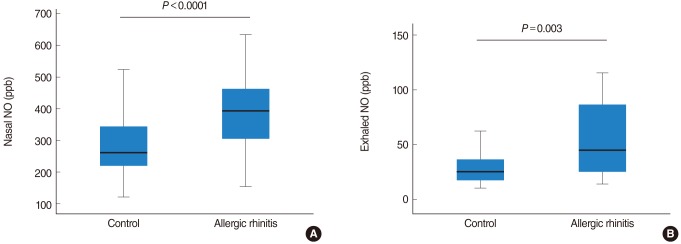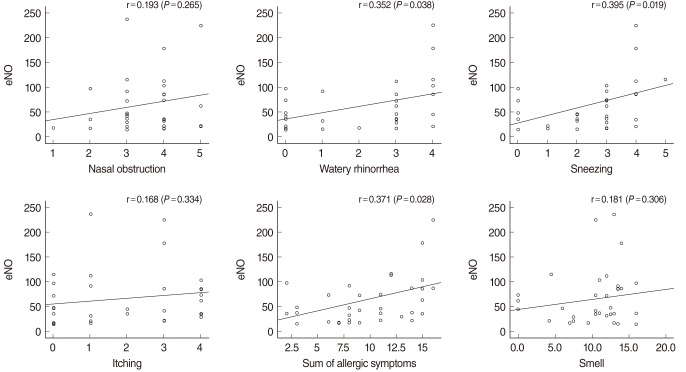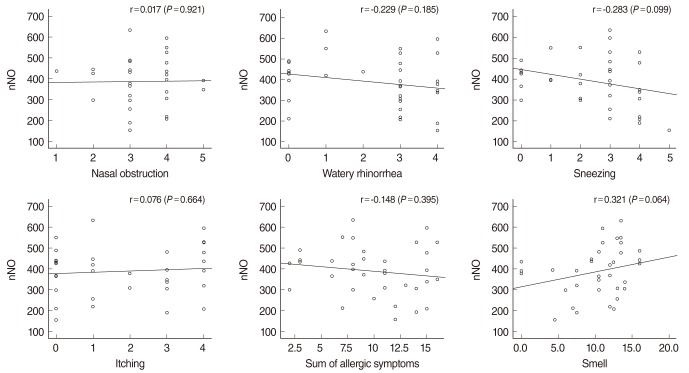Clin Exp Otorhinolaryngol.
2012 Dec;5(4):228-233. 10.3342/ceo.2012.5.4.228.
Nasal and Exhaled Nitric Oxide in Allergic Rhinitis
- Affiliations
-
- 1Department of Otolaryngology-Head and Neck Surgery, Hanyang University College of Medicine, Seoul, Korea. ent@hanyang.ac.kr
- 2Department of Internal Medicine, Hanyang University College of Medicine, Seoul, Korea.
- KMID: 1489084
- DOI: http://doi.org/10.3342/ceo.2012.5.4.228
Abstract
OBJECTIVES
The primary aim of this study was to assess whether one can use levels of nasal nitric oxide (nNO) and exhaled nitric oxide (eNO) as a means of evaluation in allergic rhinitis.
METHODS
We used a chemiluminescence analyzer to measure nNO and eNO in normal controls (n=34) and allergic rhinitis patients (n=35), and compared these measurements with various parameters of clinical symptoms and laboratory data.
RESULTS
Mean nNO (389+/-119 ppb) in allergic rhinitis patients was significantly higher than normal controls (276+/-88 ppb). Without asthma, mean eNO (64.8+/-55.9 ppb) in allergic rhinitis patients was significantly higher than normal controls (33.0+/-24.0 ppb). In the persistent allergic rhinitis group, eNO concentration was significantly higher, while nNO concentration was significantly lower than the intermittent group.
CONCLUSION
We can use nNO and eNO levels for evaluation of allergic rhinitis. However, we should consider the fact that nNO levels can be reduced, when symptoms are severe and long-lasting. Additionally, in allergic rhinitis, eNO can be elevated without asthma.
Figure
Cited by 2 articles
-
Nasal Nitric Oxide Is Correlated With Nasal Patency and Nasal Symptoms
Lei Ren, Wei Zhang, Yuan Zhang, Luo Zhang
Allergy Asthma Immunol Res. 2019;11(3):367-380. doi: 10.4168/aair.2019.11.3.367.Nasal Nitric Oxide as an Objective Evaluation Tool for Treatment Response in Chronic Rhinitis
Sangeun Lee, Su Mi Seong, Hyeop Oh, Jihun Yoon, Bo Hae Kim, Joo Hyun Park, Yun-Sung Lim, Chang Gun Cho, Seok-Won Park, Jin Youp Kim
J Rhinol. 2025;32(1):40-47. doi: 10.18787/jr.2025.00009.
Reference
-
1. Scadding G. Nitric oxide in the airways. Curr Opin Otolaryngol Head Neck Surg. 2007; 8. 15(4):258–263. PMID: 17620900.
Article2. American Thoracic Society. European Respiratory Society. ATS/ERS recommendations for standardized procedures for the online and offline measurement of exhaled lower respiratory nitric oxide and nasal nitric oxide, 2005. Am J Respir Crit Care Med. 2005; 4. 171(8):912–930. PMID: 15817806.3. Kawamoto H, Takumida M, Takeno S, Watanabe H, Fukushima N, Yajin K. Localization of nitric oxide synthase in human nasal mucosa with nasal allergy. Acta Otolaryngol Suppl. 1998; 539:65–70. PMID: 10095865.4. Kawamoto H, Takeno S, Yajin K. Increased expression of inducible nitric oxide synthase in nasal epithelial cells in patients with allergic rhinitis. Laryngoscope. 1999; 12. 109(12):2015–2020. PMID: 10591366.
Article5. Kharitonov SA, Rajakulasingam K, O'Connor B, Durham SR, Barnes PJ. Nasal nitric oxide is increased in patients with asthma and allergic rhinitis and may be modulated by nasal glucocorticoids. J Allergy Clin Immunol. 1997; 1. 99(1 Pt 1):58–64. PMID: 9003212.
Article6. Djupesland PG, Chatkin JM, Qian W, Cole P, Zamel N, McClean P, et al. Aerodynamic influences on nasal nitric oxide output measurements. Acta Otolaryngol. 1999; 119(4):479–485. PMID: 10445065.7. Arnal JF, Didier A, Rami J, M'Rini C, Charlet JP, Serrano E, et al. Nasal nitric oxide is increased in allergic rhinitis. Clin Exp Allergy. 1997; 4. 27(4):358–362. PMID: 9146927.
Article8. Maniscalco M, Sofia M, Carratu L, Higenbottam T. Effect of nitric oxide inhibition on nasal airway resistance after nasal allergen challenge in allergic rhinitis. Eur J Clin Invest. 2001; 5. 31(5):462–466. PMID: 11380599.
Article9. Palm JP, Alving K, Lundberg JO. Characterization of airway nitric oxide in allergic rhinitis: the effect of intranasal administration of L-NAME. Allergy. 2003; 9. 58(9):885–892. PMID: 12911417.
Article10. Baraldi E, Azzolin NM, Carra S, Dario C, Marchesini L, Zacchello F. Effect of topical steroids on nasal nitric oxide production in children with perennial allergic rhinitis: a pilot study. Respir Med. 1998; 3. 92(3):558–561. PMID: 9692122.
Article
- Full Text Links
- Actions
-
Cited
- CITED
-
- Close
- Share
- Similar articles
-
- Changes in levels of fractional exhaled and nasal nitric oxide after treatment in allergic rhinitis
- Clinical application of fractional exhaled nitric oxide in pediatric allergic rhinitis
- The Role of Nitric Oxide in the Nasal Mucosa and Rhinitis
- Measurement of Nasal and Exhaled Nitric Oxide in Nasal Disease
- Role of Fractional Exhaled Nitric Oxide in Predicting Development of Allergic Rhinits in Children with Bronchial Asthma




